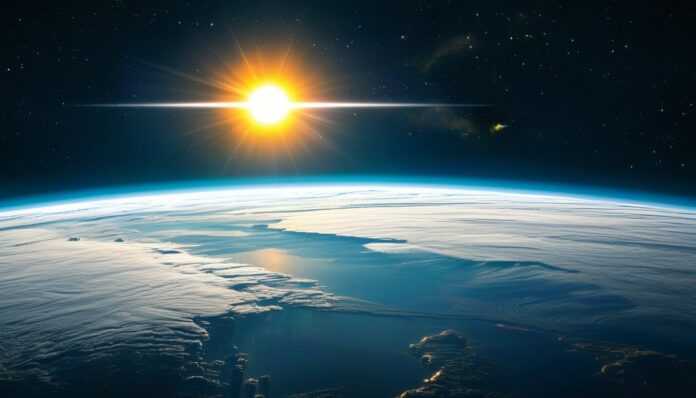The Sun – this is what allows life to exist on Earth. And if it were slightly closer or farther away from Earth, everything would be very different. Venus is closer to the Sun than Earth, but there is no life on it. The next planet after Earth (Mars) is slightly farther away from the Sun – and there seems to be no life there either. However, there is soon to be an expedition to Mars, but that’s a topic for another article.
Since ancient times, people have noticed the influence of the Sun on life. They worshipped it, studied it carefully, and kept an eye on it.
Characteristics of the Star Named Sun:
In the galaxy called the Milky Way, the Sun has relatively large dimensions, but there are stars much larger than it. In terms of brightness, only 15% of stars surpass this object.
- The diameter of the Sun is 1,391,000 kilometers.
- Mass – 2 times 10 to the power of 30 kilograms.
- The temperature of the star varies. On the surface, it’s about 5726 degrees Celsius. The crown of the luminary is heated to 1,500,000 degrees, and the core temperature reaches 13,500,000.
- The color of the star is white, although it appears yellow from Earth. Like Earth, the Sun has two poles – north and south. But unlike our planet, there are also magnetic lines that change their position every 11 years. This is explained by large solar energy emissions.
Interesting Facts About the Sun:
- Solar flares affect not only human life but also technology. Interestingly, in 1859, telegraph lines stopped working all over the Earth. This happened because of a powerful energy eruption on the Sun. It was so powerful that auroras were observed in the subtropics. During these eruptions, so much energy is released that it would last humanity for 1 billion years.
- Everyone knows that the Sun has spots. These are areas where the surface temperature is significantly lower. Compared to other stars, these spots are small. Their size depends on the degree of heating of the star. Colder objects have much larger spots.
It takes 8 minutes for sunlight to reach our Earth. In addition to light, the Sun also sends solar radiation to our planet. However, the Earth’s atmosphere and magnetic field protect us from its negative effects. - Scientists have calculated the approximate age of the star. It is approximately 4.6 billion years old. According to all calculations, its life span in the future will be the same. Then it will begin to expand and destroy the planets it currently illuminates.
The planet Earth revolves around the Sun and completes one orbit in 1 year. But the luminary itself also moves around the central part of the Milky Way. And this rotation takes 240 million years. - The star burns 4 million tons of matter, which it consists of, in just 1 second. When all the hydrogen, which makes up 92% of the Sun, is burned, it will turn into a red giant. This will happen in billions of years, but then Earth, Mars, Venus, and Mercury will cease to exist.
The mass of the Sun is not sufficient to turn it into a supernova. But when its life ends, it will become a white dwarf and will exist indefinitely, cooling down. Because it will lose its shell and become a nebula. - Earth has “only” 1.1 billion years left to live. By that time, the brightness of the Sun will increase so much that the surface of our planet will be scorched, and the oceans will turn into boiling liquid. Read about what will happen when the Sun goes out?
- Even on such a hot star, there is water. And there is much more of it there than on our planet. Simply put, water exists there in the form of vapor. But it is not located on the surface itself but in one of the layers that make up the atmosphere of this Sun.
- Prominences are flares on the Sun. So, the size of one of them exceeds the size of our entire Earth. And the stellar luminary also produces solar wind, and it has long been learned to use it. Spacecraft are accelerated using this force.
- Many people think that the Sun is just a solid hot sphere. In fact, this is not the case. Like other celestial objects, it consists of different atmospheric layers.
- The Sun has a corona that cannot be seen directly. But during a total solar eclipse, this phenomenon appears to those living on Earth. Then it can be observed with the naked eye. Just don’t forget to use protective eyewear, or you can damage the retina of your eye.
- The ancient Greeks were convinced that the Sun was just like the other planets in the solar system. And until 1992, the Vatican did not recognize that the Earth revolves around the Sun.
- The distance from Earth to the Sun is 394 times greater than the distance to the Moon. Taking into account that American space researchers reached our satellite in 3 days, the journey to the star will take 1182 days.
- There was a period on Earth for several decades when temperatures on the planet were very low. This happened in the 17th century and was associated with a sharp decrease in luminary activity.
- Sunlight has a significant impact on human health, as does its absence. In the North, where people do not see bright sunlight for a long time, they have not only physical health problems but also psychological stress throughout this period.
